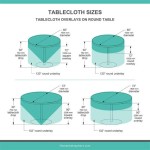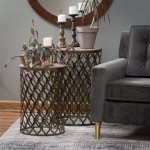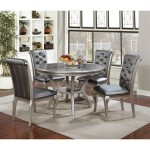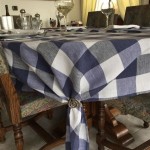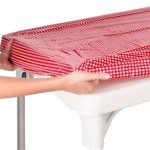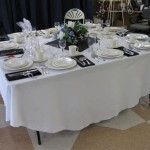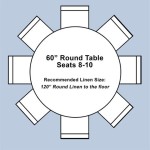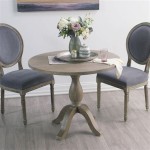How to Make a Large Tablecloth Fit Smaller Table Sizes
A common household dilemma involves possessing a beautiful tablecloth that, unfortunately, exceeds the dimensions of the intended table. This situation often arises from inheriting family heirlooms, purchasing tablecloths without accurate measurements, or simply downsizing furniture. Rather than relegating the oversized tablecloth to storage, several practical and aesthetically pleasing methods exist to adapt it for use on smaller tables. The effectiveness of each method hinges on the tablecloth's material, the table's shape, and the desired aesthetic outcome.
Understanding the Problem of Excess Tablecloth
The primary concern when using a large tablecloth on a smaller table lies in managing the excess fabric. An unaddressed overhang can appear sloppy, create tripping hazards, and generally detract from the table's visual appeal. Moreover, depending on the fabric weight and texture, an overwhelming amount of draped material can feel cumbersome and impractical. The goal is to minimize the excess while maintaining a balanced and attractive presentation. It's important to consider the desired drop length – the amount of fabric that hangs over the table's edge. Standard drop lengths typically range from 8 to 12 inches, offering a pleasing balance between practicality and visual appeal. However, this can be adjusted based on individual preferences and the specific context of the table setting.
Before attempting any modifications, meticulous measurements are crucial. First, accurately measure the length and width (or diameter, for a round table) of the table. Then, determine the desired drop length. Multiply the desired drop length by two (to account for both sides of the table) and add this value to each of the table's dimensions. This calculation provides the ideal tablecloth size. The difference between the actual tablecloth size and the ideal size reveals the extent of the excess fabric that needs to be addressed. Having these figures ensures a more precise and successful adaptation process.
Method 1: Strategic Folding
Folding represents the simplest and most reversible method for adapting an oversized tablecloth. This approach is particularly suitable for rectangular or square tables and tablecloths, allowing for relatively straightforward adjustments. The key lies in creating neat, even folds that distribute the excess fabric subtly and uniformly.
The initial step involves centering the tablecloth on the table. Ensure that the same amount of excess fabric hangs on each side. This symmetrical arrangement provides a balanced foundation for the folds. Next, beginning at one side, create a fold along the edge of the tablecloth. The width of the fold depends on the amount of excess fabric. For a moderate excess, a fold of 2-4 inches may suffice. For a more substantial excess, a wider fold will be necessary. Ironing the fold immediately after creating it ensures a crisp, clean line and helps to maintain its shape. This is especially important for fabrics that tend to wrinkle easily, such as linen or cotton.
Repeat the folding and ironing process on the opposite side of the tablecloth, striving for symmetrical folds. Consistency in the fold width is essential for achieving a balanced look. If the initial folds are insufficient to achieve the desired drop length, repeat the folding process, creating a second or even third fold on each side. With each successive fold, it's crucial to iron the crease to maintain a neat and professional appearance. The corners may require extra attention to ensure they lie flat and do not bunch up. Tucking the corners neatly under the folds can help to create a more streamlined silhouette.
For round tables, folding becomes slightly more challenging but still feasible. The principle remains the same: to create even folds that distribute the excess fabric uniformly. In this case, the folds will radiate outward from the center of the table, like the spokes of a wheel. Start by centering the tablecloth and then create the first fold. Carefully iron the fold to set the crease. Repeat this process around the circumference of the table, creating evenly spaced folds. The number of folds will depend on the amount of excess fabric and the desired aesthetic. Tucking the resulting points around the base of the table can help to conceal the folds and create a smoother, more unified look.
Method 2: Utilizing Table Skirts or Runners
Employing table skirts or runners offers a creative and visually appealing solution for managing oversized tablecloths. This method is particularly effective for adding texture, color, and visual interest to the table setting. The underlying principle involves using the skirt or runner to conceal or complement the excess fabric of the tablecloth.
A table skirt, typically made of fabric and attached to the tabletop with clips or Velcro, can effectively conceal the excess fabric. First, center the oversized tablecloth on the table, allowing the excess to hang down. Then, attach the table skirt around the perimeter of the table, ensuring that it covers the excess fabric completely. The skirt can be chosen to match or contrast with the tablecloth, depending on the desired aesthetic. Pleated skirts add a touch of formality, while gathered skirts offer a more casual and relaxed look. Consider the overall style of the room and the occasion when selecting the table skirt.
Table runners, long and narrow pieces of fabric that run down the center of the table, can also be used to camouflage excess fabric. In this case, the tablecloth is allowed to drape naturally, and the runner is placed over it, drawing the eye away from the excess fabric. The runner can be chosen to complement the tablecloth or to add a pop of color or pattern. Two or more runners can also be used across the table, as placemats, to provide cover to the extra cloth. This method works particularly well with tablecloths that have a subtle pattern or texture, as the runner can enhance these features rather than compete with them.
Another variation involves using multiple smaller tablecloths or fabric panels in conjunction with the oversized tablecloth. The larger tablecloth serves as a base, and the smaller pieces are layered on top to create visual interest and to conceal the excess fabric. For example, a rectangular tablecloth can be combined with a square or round tablecloth to create a layered effect. This approach allows for a greater degree of customization and creativity in the table setting.
Method 3: Altering the Tablecloth Permanently or Semi-Permanently
For situations where reversible methods are insufficient or undesirable, altering the tablecloth offers a more permanent solution. This approach involves cutting and hemming the tablecloth to fit the table precisely. While this method requires a certain level of sewing skill, it provides the most tailored and polished result.
Before commencing any cutting, meticulous measurements are paramount. Accurately measure the table and determine the desired drop length, as described earlier. Then, using a fabric marker or tailor's chalk, mark the cutting lines on the tablecloth, ensuring that the lines are straight and accurate. It is advisable to err on the side of caution and leave a small amount of extra fabric, as it is always easier to trim more fabric than to add it back.
Once the cutting lines have been marked, carefully cut the tablecloth along the lines using sharp fabric scissors. A rotary cutter and cutting mat can also be used for more precise cuts, especially for large tablecloths. After cutting, the raw edges of the fabric need to be hemmed to prevent fraying and to create a finished look. The hem can be sewn by hand or with a sewing machine. A simple folded hem, where the fabric is folded over twice and then stitched, is a common and effective method. A more decorative hem, such as a rolled hem or a blind hem, can also be used, depending on the desired aesthetic.
For those who lack sewing skills or prefer a less permanent alteration, fusible hem tape offers a no-sew alternative. This tape is applied to the raw edges of the fabric and then ironed, creating a bond that adheres the fabric together. While fusible hem tape is not as durable as a sewn hem, it provides a quick and easy solution for adapting an oversized tablecloth.
Another semi-permanent approach involves using fabric glue or adhesive to create temporary hems or alterations. This method is suitable for tablecloths that are not frequently washed or subjected to heavy use. The fabric glue is applied to the raw edges of the fabric, and then the edges are folded over and pressed together. While this method is less durable than a sewn hem, it provides a temporary solution for adapting the tablecloth to a smaller table. The glue can be removed later, but care should be taken to not damage the fabric.
Ultimately, the most suitable method for adapting a large tablecloth to a smaller table depends on various factors, including the tablecloth's material, the table's shape, the desired aesthetic, and the individual's skill level and preferences. By carefully considering these factors and following the steps outlined above, it is possible to transform an oversized tablecloth into a beautiful and functional addition to the table setting.

Tablecloth Size Guide Table Linen Hire Tips Plato Catering

Let S Talk Linens The Ultimate Guide To Table Linen Sizes Party Al Ltd Pink Hippo Blog

60 Second Diy Fitted Rectangular Tablecloth Cv Linens

Fitted Table Cover The Easy Diy

Let S Talk Linens The Ultimate Guide To Table Linen Sizes Party Al Ltd Pink Hippo Blog

Tablecloth Size Chart

Tablecloth Size Chart Asap Linen

Urby 90 X 132 Inch Polyester Rectangular Table Cloth For 8 Foot That Seats 10 Person Fits Large Folding Tables Picnic Dining

How To Measure A Table Linen Measurements

3 Easy Ways To Measure Tablecloth Sizes Your Table Linens Size Guide
Related Posts

